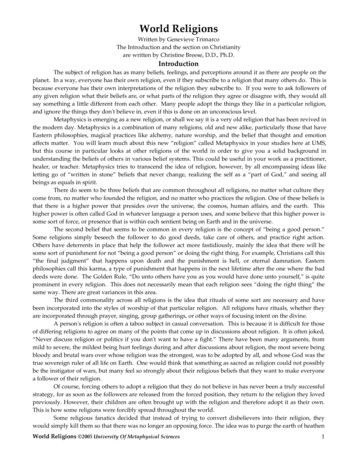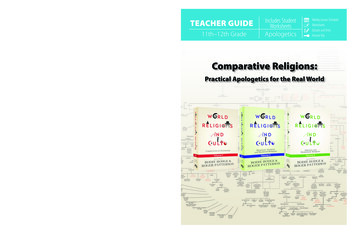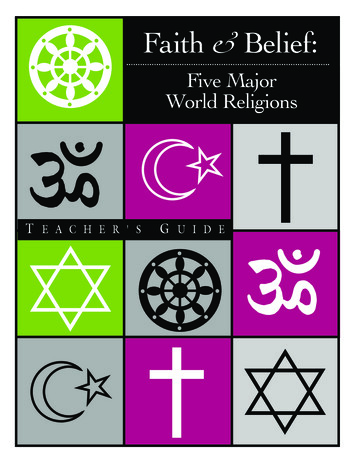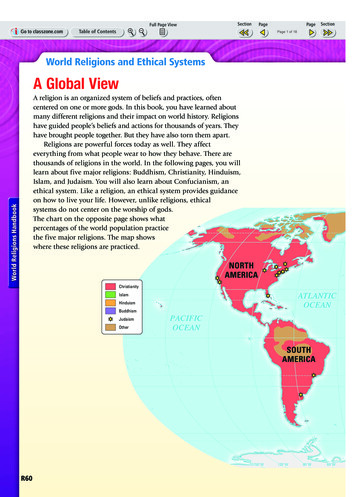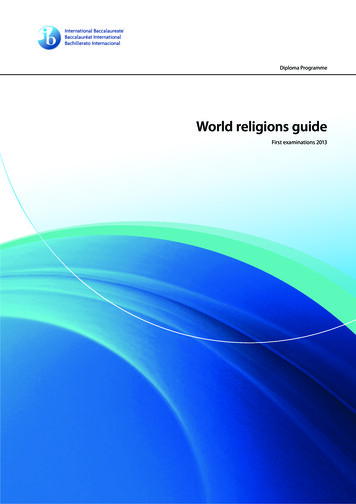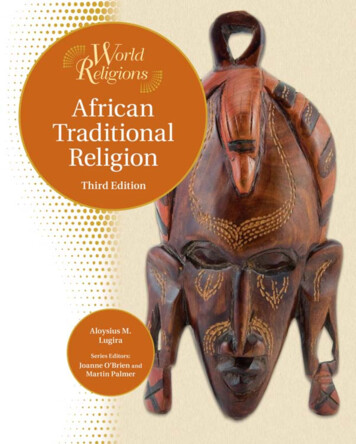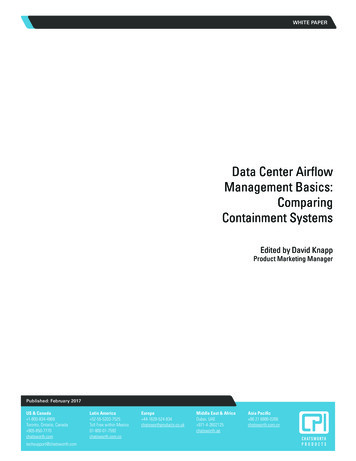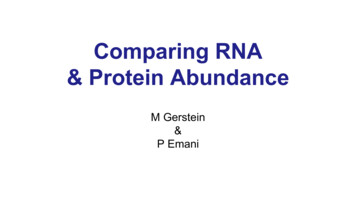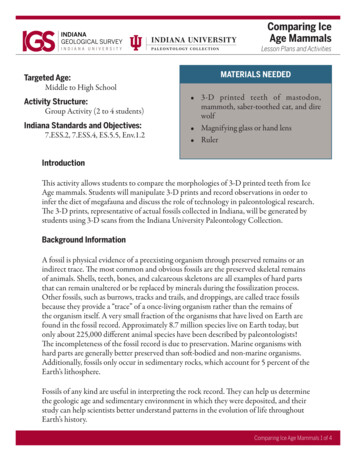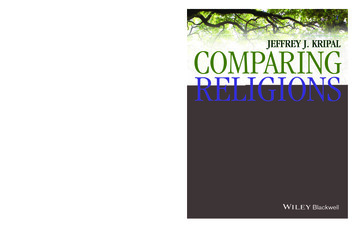
Transcription
Comparing Religions is a next-generation textbook that teaches the art and practice of comparison as a vital skillin our modern globalizing world. Using a three-part “initiatory” structure, the book provides the reader with amap and an effective process through which to understand and practice the comparative analysis of religion.The three-part structure leads readers through: an historical outline of comparative practices, both in world history and in the modern West,demonstrating that comparative forms of understanding religion are ancient and global; six chapters focusing on classic comparativist themes, exploring and modeling the nature ofresponsible comparativist practice; the exploration of a number of key strategies through which to understand, analyze, and re-readreligion with a sense of accomplishment and closureThe result is a fascinating, wide-ranging, and genuinely exciting book that will inspire as well as guide readerswho wish to think seriously about religious pluralism in the modern world. By embracing the last three decadesof comparative work and critical theory, the book strikes a new balance and offers a positive vision of the field’smost promising future. Throughout, the impact of comparativist practices on individuals is fully acknowledgedand worked with. Toward this same end, the book contains numerous features to help students, professionals andinterested readers understand this challenging but extraordinarily rich area of critique and wonder.The supporting website features numerous additional resources, including information on individualreligious traditions, images, a glossary, discussion questions, links to other sites. These resources areavailable at www.wiley.com/go/kripal.Jeffrey J. Kripal is the J. Newton Rayzor Professor of Religious Studies at Rice University. His most recent publications include Mutantsand Mystics: Science Fiction, Superhero Comics, and the Paranormal (2011); Authors of the Impossible: The Paranormal and theSacred (2010); Esalen: America and the Religion of No Religion (2007); and The Serpent’s Gift: Gnostic Reflections on the Study ofReligion (2007).ISBN 978-1-4051-8458-8900009 781405 184588Comparing Religions“Armed with an extensive array of case studies and a richly diverse portfolio of illustrations, Kripal not only providesa lucid survey of the ‘facts’ of the world’s religions, but inspires us to embrace the fundamentally transcendent natureof the religious experience in all of its manifestations, both ordinary and uncanny, and to confront the inherentchallenges of studying religion in a responsibly comparative manner. Comparing Religions is a masterly exampleof how a book intended for the classroom can be an invigorating stimulus toward new ways of thinking about aphenomenon that pervades every aspect of our world.”Sarah Iles Johnston, The Ohio State UniversityKripal“This book offers the most original and provocative recasting of the comparative study of religion in decades, andit’s aimed just where we need this rethinking the most: the classroom. Other textbooks tend to work with a checklistof subjects as they summon the major religions serially to the stage. Kripal starts instead with the mystery of thecomparative act itself, allowing that to determine what he brings forward for our attention. So it’s charisma, sex, theparanormal, and ‘soul practices’ more than it’s Hinduism, Buddhism, Islam. Kripal recognizes the comparativist ineach of us and urges us to take it seriously. The result is deep and wide, and excitingly open-minded.”John Stratton Hawley, Barnard College, Columbia UniversityJeffrey J. KripalComparingReligions
Praise for Comparing Religions“Jeffrey Kripal provides a thoughtful and compelling discussion of key themes, ideas, and challenges that groundthe study of religion across traditions and geographies. It is a layered and textured treatment that will capture theimagination and engage students from start to finish. This important and timely text is not to be missed.”Anthony B. Pinn,author of Introducing African American Religion“Comparing Religions is a lucid, entertaining, and even fun introduction to the comparative study of religion. Itwill be effective with its target audience, young people and the undergraduate classroom, because, while theymust wrestle with the way scholars deconstruct and reduce to social or evolutionary functions such phenomena,Kripal never loses sight of the experiences and meanings of those transformed by, engaged in, and mobilizedthrough it. There is no better single volume to entice students into the fraught and fascinating study of religion.”Bron Taylor,author of Dark Green Religion: Nature Spirituality and the Planetary Futureand editor of The Encyclopedia of Religion and Nature“Kripal is at his very best in this exceptional introduction to the study of religion. After a self-reflexive journeythrough the religious realms of myth, ritual, nature, science, sex, charisma, soul, salvation, and the imaginationand its paranormal powers, we are guided to put it all back together with an eye to religious tolerance, freedom,and pluralism. This book is the red pill. Ingest it and you will be enlightened.”April D. DeConick,Rice University“Armed with an extensive array of case studies and a richly diverse portfolio of illustrations, Kripal not only provides a lucid survey of the “facts” of the world’s religions but also inspires us to embrace the fundamentallytranscendent nature of the religious experience in all of its manifestations, both ordinary and uncanny, and toconfront the inherent challenges of studying religion in a responsibly comparative manner. Comparing Religionsis a masterly example of how a book intended for the classroom can be an invigorating stimulus toward newways of thinking about a phenomenon that pervades every aspect of our world.”Sarah Iles Johnston,The Ohio State University“This book offers the most original and provocative recasting of the comparative study of religion in decades,and it’s aimed just where we need this rethinking the most—the classroom. Other textbooks tend to work witha checklist of subjects as they summon the major religions serially to the stage. Kripal starts instead with the mystery of the comparative act itself, allowing that to determine what he brings forward for our attention. Soit’s charisma, sex, the paranormal, and “soul practices” more than it’s Hinduism, Buddhism, and Islam. Kripalrecognizes the comparativist in each of us and urges us to take it seriously. The result is deep and wide, andexcitingly open minded.”John Stratton Hawley,Barnard College, Columbia University
Comparing ReligionsComing to TermsJeffrey J. Kripalwith Ata Anzali, Andrea R. Jain, and Erin ProphetThe Reader (2011), digital artwork by Rob Beschizza for BoingBoing and Jeffrey J. Kripal, “Psi-Fi:Popular Culture and the Paranormal.”
This edition first published 2014 2014 Jeffrey J. KripalRegistered OfficeJohn Wiley & Sons, Ltd, The Atrium, Southern Gate, Chichester, West Sussex, PO19 8SQ, UKEditorial Offices350 Main Street, Malden, MA 02148-5020, USA9600 Garsington Road, Oxford, OX4 2DQ, UKThe Atrium, Southern Gate, Chichester, West Sussex, PO19 8SQ, UKFor details of our global editorial offices, for customer services, and for information about how to apply for permissionto reuse the copyright material in this book please see our website at www.wiley.com/wiley-blackwell.The right of Jeffrey J. Kripal to be identified as the author of this work has been asserted in accordance with theUK Copyright, Designs and Patents Act 1988.All rights reserved. No part of this publication may be reproduced, stored in a retrieval system, or transmitted, in anyform or by any means, electronic, mechanical, photocopying, recording or otherwise, except as permitted by theUK Copyright, Designs and Patents Act 1988, without the prior permission of the publisher.Wiley also publishes its books in a variety of electronic formats. Some content that appears in print may not be availablein electronic books.Designations used by companies to distinguish their products are often claimed as trademarks. All brand names andproduct names used in this book are trade names, service marks, trademarks or registered trademarks of their respectiveowners. The publisher is not associated with any product or vendor mentioned in this book.Limit of Liability/Disclaimer of Warranty: While the publisher and author(s) have used their best efforts in preparing thisbook, they make no representations or warranties with respect to the accuracy or completeness of the contents of thisbook and specifically disclaim any implied warranties of merchantability or fitness for a particular purpose. It is sold onthe understanding that the publisher is not engaged in rendering professional services and neither the publisher nor theauthor shall be liable for damages arising herefrom. If professional advice or other expert assistance is required, theservices of a competent professional should be sought.Library of Congress Cataloging-in-Publication data is available for this book.ISBN 9781118774878 (hardback); ISBN 9781405184588 (paperback)A catalogue record for this book is available from the British Library.Cover image: Jaume Plensa, Mirror, 2011. Painted stainless steel / 377 243 245 cm each. Collection: Rice University,Houston, Texas, USA, photographed by Jenna L. Kripal. DACS 2013Cover design by Simon Levy AssociatesSet in 10/13pt Minion by SPi Publisher Services, Pondicherry, India12014
God Appears & God is LightTo those poor Souls who dwell in Night,But does a Human Form DisplayTo those who dwell in Realms of day.William Blake, “Auguries of Innocence”Be then, within yourself, a receptacle for the forms of all beliefs, for God is too vastand too great to be confined to one belief to the exclusion of another, for indeed Hesays, “Wheresoever ye turn, there is the Face of God.”Ibn ’Arabi, Bezels of Wisdom
About the websiteThis book has a companion website containing a range of resources for instructors,students, and other readers. The features include: a set of simple guidelines for doing responsible comparisona set of brief summaries of the standard world religion systemssuggestions for further readingan annotated bibliography of explicitly comparative worksglossarysample syllabus and teaching ideasand a range of other materials.These resources can be accessed at www.wiley.com/go/kripal.
ContentsAn Important Note to the Instructor xiA Comment on the Cover Image and the Paintings xvList of Illustrations xviAcknowledgments xxPart I Prehistory, Preparation, and Perspective Introduction: Beginnings 1 Comparative Practices in Global History: If Horses Had Hands The Comparative Practices of Polytheism The Comparative Practices of Monotheism: Early Judaism The Comparative Practices of Monotheism: Early Christianity The Comparative Practices of Monotheism: Early Islam The Comparative Practices of Asia: Hinduism The Comparative Practices of Asia: Sikhism The Comparative Practices of Asia: Confucianism, Daoism, and Buddhism in China The Tough Questions 2 Western Origins and History of the Modern Practice:From the Bible to Buddhism Deep Upstream: Mystical Humanists, Protesters, Rationalists, and Romantics Mid-Upstream: “Not as Moses Said,” or the Biblical Beginnings of Critical Theory Just Upstream: Colonialism and the Modern Births of Spirituality and Fundamentalism The Immediate Wake: Counterculture, Consciousness, Context, and Cosmopolitanism The Tough Questions 3 The Skill of Reflexivity and Some Key Categories: The Terms of Our Time Travel The History of Religions Patterns of Initiation 1391116202733363839434454586773777982
viiiContentsThe Humanities: Consciousness Studying Consciousness Cultural Anthropology and Initiation Rites Working Definitions and Their Histories The Uncertainty Principle: The Insider–Outsider Problem (and Promise) Religious Questions as Ultimate Concerns The Tough Questions Part II Comparative Acts 8588891031051061094 The Creative Functions of Myth and Ritual: Performing the World 1111131161201251331381395 Religion, Nature, and Science: The Super Natural 1431451461491541641721736 Sex and the Bodies of Religion: Seed and Soil 1771781811881921951982042057 Charisma and the Social Dimensions of Religion: Transmitting the Power 209211215221226229234235Myth: Telling the Story Telling Us Ritual: Acting Out the Story Acting Us Patterns in Myth Patterns in Ritual Comparative Practice: The Awakened One and the Great Hero in Ancient India Beginning a Toolkit The Tough Questions Religion and Contemporary Science The Paradox of the Super Natural Food and Purity Codes: “You Are What You Eat” New Directions: Space Exploration, Dark Green Religion, and Popular Culture Comparative Practice: The Human Plant The Toolkit The Tough Questions In the Beginning The Social Body: Sexuality, Gender, and Sexual Orientation Sex and Transgression Super Sexualities The Sexual Ignorance of the Religions Comparative Practice: The Two Ann(e)s The Toolkit The Tough Questions Charisma and Community The Institutionalization of Charisma: Passing on the Charge Patterns of Special Institutions The Miracle and the Saint: Signs of the (Im)possible Comparative Practice: The Flying Saint and the Levitating Medium The Toolkit The Tough Questions
Contents8 The Religious Imagination and Its Paranormal Powers: Angels,Aliens, and Anomalies System and Anomaly: Paranthropology The Sixth Super Sense The Imaginal: Not Everything Imagined Is Imaginary The Comparative Practices of Popular Culture Miracles in the Making: The Fortean Lineage Fact and Fraud: On the Trick of the Truth Comparative Practice: Supernatural Assault Traditions Adding to Our Toolkit The Tough Questions 9 The Final Questions of Soul, Salvation, and the End of All Things:The Human as Two Two Scenes The Nature of Embodied Consciousness Patterns of the Soul and Salvation in the History of Religions Soul Practices Traumatic Technologies of the Soul Comparative Eschatologies Comparative Practice: Re-Death, Near-Death, and After-Death Experiences The Toolkit The Tough Questions Part III Putting It All Together Again 28628829429629910 Faithful Re-readings: Exclusivism, Inclusivism, Pluralism, and Justice 30330631331531832133133111 Rational Re-readings: Masters of Suspicion, Classical and Contemporary 335336337340344348350357361The Task of Theology: Relating Reason and Revelation Excluding the Other Religious Worldview from One’s Own Including the Other Religious Worldview within One’s Own Encountering the Sacred within and beyond All Religious Worldviews Comparison Is Justice: Liberation, Black, Feminist, and Queer Theologies Nuances: Faith and Scholarship The Tough Questions When Religion Doesn’t Work On the Heart of Reductionism: “There Is No Gap” Sigmund Freud: Religion Is a Childish Illusion Émile Durkheim: Religion Is Society Worshipping Itself Postcolonial Theory: The Gaze of Empire On Spirit and Spandrels: Cognitive Science, Evolutionary Psychology, and Cultural Evolution The Study of Religion and Violence before and after 9/11 The Tough Questions
xContents12 Reflexive Re-readings: Looking at the Looker 365366368371372379383389392 and Cosmos: Epilogue from Houston 397The School of the More Four Exemplars of Reflexive Re-reading The Phenomenology of Religion: What Is versus What Appears Reflexively Re-reading Miracle: The Man in the Door The Filter Thesis: The Door in the Man Neuroscientists at the Cusp Concluding Thoughts: Culture, Cognition, and Consciousness The Tough Questions Glossary 401Index 413
An Important Note to the InstructorOr Why You Should (or Should Not) Teach This TextTruly speaking, it is not instruction, but provocation that I can receive from another soul.Ralph Waldo Emerson, Divinity School Address, 15 July 1838Education is not the filling of a pail, but the lighting of a fire.This is a book that focuses on the histories, nuances,promises, and costs of different comparative practices and their potential importance for our contemporary world, not on the content of the religionsthemselves. It is about exactly what it announcesin its subtitle: “coming to terms” with the comparative method itself. This means understanding the comparative method’s ancient roots in the religionsthemselves and, above all, in radical, often heterodoxmystical forms of experience and expression. Itmeans understanding the method’s paradoxicalstructures and simultaneous challenges to bothrationalist reductionism and dogmatic religiousbelief: understanding them “beyond reason” in onecase and “beyond belief ” in the other. It meansrefusing to demean and dismiss the comparativeenterprise with perfectly true half-truths and a historical consciousness that can see no further backthan a few hundred years. It means recognizingcomparison everywhere, from the polytheistic logicof ancient Egyptian, Greek, and Roman religions,through the Indian poet Kabir and his radicalsinging beyond Hindu and Muslim identity, toDarwin’s Origin of Species and the most basiccognitive structures of the human brain, as mappedWilliam Butler Yeatsin modern neuroscience. But, above all, this “comingto terms” means acknowledging and workingthrough the very real existential costs (cultural,emotional, religious, familial, and moral) that adisciplined comparative practice demands of anyonewho dares take up its call.Obviously, then, this is not a “world religions”textbook of the kind that goes through each majorreligion, treats all of them as more or less closed systems of practice and thought, and leaves them mostlyunchallenged at the end. I am by no means againstsuch an approach, and I recognize that it can serveall sorts of important remedial purposes. I must confess to a deeper disquiet, though; for I have come tosee, with many a colleague (maybe you), that thestandard “world religions” approach tends to leavemost of the interesting questions and all of the mostdifficult ones unasked, much less answered. It canalso, all too easily, leave unchallenged traditionalforms of religious identity and their identity politics,which has played such a central role in real-worldconflict. In the language of the historian of religionsCharles Long, what I have grown most concernedabout is the way in which our academic disciplinehas helped produce a whole series of significations,
xiiAn Important Note to the Instructorthat is, signs that are much too certain of themselvesand that, moreover, hide or suppress their own constructed nature.1 Students can walk away from sucha classroom confirmed in their convictions that theyare indeed an eternal this or that, instead of a humanbeing born into a particular cultural context andtaking on a particular social and religious identitythat is itself largely determined by previous historical processes, cultural debates, institutions, andviolences.This insight into the constructed nature of alltypes of social and religious identity can be quite disturbing. Or quite liberating. If, after all, we cantake apart these social constructions, we can alsoput them back together again, in new and more adequate forms.This taking apart and putting back together iswhat the present book is all about. Its basic premise isthat a truly effective pedagogy needs to identify theexistential costs of the modern study of religion andthen deal with them openly and positively. Put moredirectly, this text asks us, as both teachers and students, to own up to the radicalism of what we areactually doing in the study of religion. Just as importantly, it asks us to hope for far more from the studyof religion than we are accustomed to hoping. Itwarns and celebrates.Comparing Religions attempts to accomplish thisdouble goal through a modal initiatory structure.The book is divided into three distinct parts: (1) afirst part of three chapters in which we historicallylocate the comparative practices discussed here andask the students to define their worldviews as theyprepare to take up their own comparative practices;(2) a middle or “liminal” part of six chapters inwhich we guide the student/reader through a seriesof comparative acts that are meant to be illustrativebut by no means exhaustive; and (3) a final part ofthree chapters in which we ask the student/readersto “come back” to their own beliefs and convictionsand to restate them in the light of the comparativeacts in which they have engaged over the last fewmonths. The entire book, in short, is organizedaround the naming, questioning, and revisioning ofthe religious or secular identities of the studentsthemselves.There are five things to emphasize here.1 The first and most important thing to say is thatthe textual initiation, like any initiation, is not foreveryone and so requires an initial taking of responsibility and a moral assent on the part of the student orreader. That is to say, the student needs to be told, upfront and immediately, that the existential risks arevery real here and that what follows may well feel likean ordeal or trial, even as it points toward a potentialtransformation at the end.2 The second thing to emphasize is that the basicspirit and intent of the book is positive and constructive,not negative and deconstructive. The text certainlyembraces, celebrates, and practices a whole spectrumof reductive and deconstructionist methods (there isplenty here to provoke just about anyone, includingthe secularist and materialist), but it does not leavethe student hanging in the end, without anythingpositive or hopeful to take away. It does not deconstruct “religion” down into a depressing mush. Ratherthe book is explicitly designed to help the studentengage the critical study of religion in its full force andthen emerge from this engagement with a positiveand constructive outlook on how to re-read religion.3 The third thing to emphasize is that, in both structure and conversational tone, the text is focused on theindividual reader. So, for example, in the third andfinal part we offer the students a number of options,leaving it to the individual to choose one (or two orthree) of these. The goal, obviously, is not to reach the“correct” answer (the comparative study of religion isnot a standardized multiple-answer test), but toarrive at a new level of reflexivity and awarenessabout how religious worldviews function, how theycome to be (and come not to be), and how they workin relation to other worldviews.4 Fourthly, the book privileges structure over content.The initiatory or tripartite structure has one major,
An Important Note to the Instructorand perhaps surprising, implication: in some realsense, it does not matter what you teach in the middle section of the course. What does matter is thatyou provide the students with enough “confusion”and “difference” here in order to challenge (andthereby sharpen, deepen, or broaden) their specificworldviews and assumptions about sameness, whatever those happen to be. Put a bit differently, in theend it does not matter so much what that confusionor difference is, only that the matter is sufficientlyconfusing and different.Toward this end, we have provided a set of chapters on six robust comparative themes, many ofwhich we hope you find useful. But you should feelno pressure to use all of them, and you, of course,should feel free to substitute your own. I would alsostrongly encourage you to provide sets of lectures onat least three different religious traditions at this“liminal” point in the course. The book, in otherwords, is explicitly designed to work in tandem withan expert: that is, with you. So play to your strengthshere. I did.The flipside is that I am keenly aware of what I donot know, which is really everything other than thefew things I do know. Accordingly, I approached thefive years it took to write this text with a sensibilitythat bounced back and forth somewhere betweenhumility, moral despair, and professional terror.Which is all to say that I am all too aware of the text’sshortcomings and limitations, particularly withrespect to content and cultural reach. I am especiallyaware of the book’s slim treatment of indigenous andtribal religions. I ask you, then, to read and use thesepages not as a vain attempt to cover everything, butas one colleague’s sincere effort to capture somethingof the fire that first brought so many of us to the fieldin the first place. I am mostly after that fire, not afterthe different pieces of wood that feed it.5 Fifthly and finally, the book privileges the extraordinary and the uncanny over the ordinary and thecommon. This is probably its primary originality(and offense). I am, after all, hyper-aware that colleagues have argued, and continue to argue, for theexactly opposite approach, namely that we need toget away from the religious as the fantastic, as theweird, as the strange. We should not be exoticizingreligion. We should be normalizing it. J. Z. Smith’seloquent plea, in Imagining Religion (1982), for studying religion in the ordinary rather than in theexotic—in “what we see in Europe every day” ratherthan in those things “which excite horror and makemen stare”—is perhaps the most famous example ofthis position: a position that he captured again, perhaps humorously, in the title of his third collection ofessays, Drudgery Divine (1990).2Like many, I consider Smith to be a pillar of the field,and I understand and respect this commitment to theordinary, particularly if one is more sociologicallyinclined. The statistical and demographic methods ofsociology, after all, flatten out and finally erase theanomalous: they turn the divine into the drudgery ofSmith’s book title. But I happen to think that this normalizing and flattening out of the sacred is largely afunction of what we have chosen to take off the table.That is, it is a function of what we have chosen to focuson and what we have refused to look at seriously. If weput other things on the table again (as this text clearlydoes), the field looks very different and, I dare say,much more attractive and exciting to an eighteenyear-old (not to mention this fifty-year-old).Let me lay my cards on the same table: because Iwork in comparative mystical literature, a literaturethat features some of the most extreme experienceson record, I have come to conclude that actual historical human encounters with the sacred are uncanny,are fantastic, indeed they are often so strange that wecannot possibly exaggerate this weirddom. I evenhave a personal rule, which I developed out of myethnographic experiences with individuals who haveknown such encounters up close and personal: themore one discovers about these kinds of events, theweirder they get. Put differently, such historiesbecome more improbable, not less, the more we knowabout them. I am thus skeptical of models of religionthat focus on the normal, on the everyday, and on theways these events are domesticated, rationalized, andxiii
xivAn Important Note to the Instructorinstitutionalized. All that, too, is “religion”— ofcourse. Maybe it is most of religion. But, if we onlyfocus on these social processes, we will get a very flatview of religion, which is exactly what we have todayin much of the field.I also have a deeper concern here, namely that normalizing scholarship on “ordinary” religion is part ofthis same domestication, rationalization, and erasureof the sacred. It is as if we can study everything aboutreligion, except what makes it fiercely religious. Andthen we are told that there is nothing essentially orreally religious about religion, which of course is trueif we have just erased all of the weird stuff with ourmethods and philosophical assumptions. If we havetaken everything off the table that can challenge ourown reigning materialisms, relativisms, and constructivisms, then everything will look like more evidence for materialism, relativism, and constructivism.Which is where we are at the moment.I am always humorously reminded of a classicsci-fi movie at this point in my long-standingargument with the field. Our present materialist andhistoricist models have rendered human naturesomething like the protoganist Scott Carey in thefilm The Incredible Shrinking Man (1957). Withevery passing decade, that human nature is gettingtinier and tinier and less and less significant. In a fewmore years we’ll just blip out of existence, like poorScott at the end of the film, reduced to nothing morethan cognitive modules, replicating strings of DNA,quantum-sensitive microtubules in the synapses ofthe brain, or whatever. Either that, or these samemethods will simply kill us off. Indeed, at this point,we are constantly reminded of the “death of the subject” and told repeatedly that we are basically walkingcorpses with computers on top—in effect, technological zombies or moist robots. We are in the fantastically ridiculous situation where consciousintellectuals are telling us that consciousness doesnot really exist as such, that there is nothing to itexcept cognitive grids, software loops, and warmbrain matter. If this were not so patently absurd, itwould be very funny.Why do we want to be so incredibly small?And why do we allow these present philosophicalassumptions—and they are assumptions—to eraseentire swaths of the history of religions, which givepowerful witness to the exact opposite, namely thathuman nature is immense, that mind is not brain,that consciousness is not cognition, and that there issomething fundamentally transcendent about, well,us? This does not mean that we should then deny orignore the everyday, the institutional politics, the violences, the daily rituals, the emotions and sensibilitiesof piety, the visual art and material culture, the demographics, “what we see in Europe every day.” Ofcourse not. Why do we have to keep playingping-pong here? Back and forth. Back and forth. As ifwe could not simply do bot
phenomenon that pervades every aspect of our world.” Sarah Iles Johnston, The Ohio State University Comparing Religions is a next-generation textbook that teaches the art and practice of comparison as a vital skill in our modern globalizing world. Using a three-part “initiatory” struct
